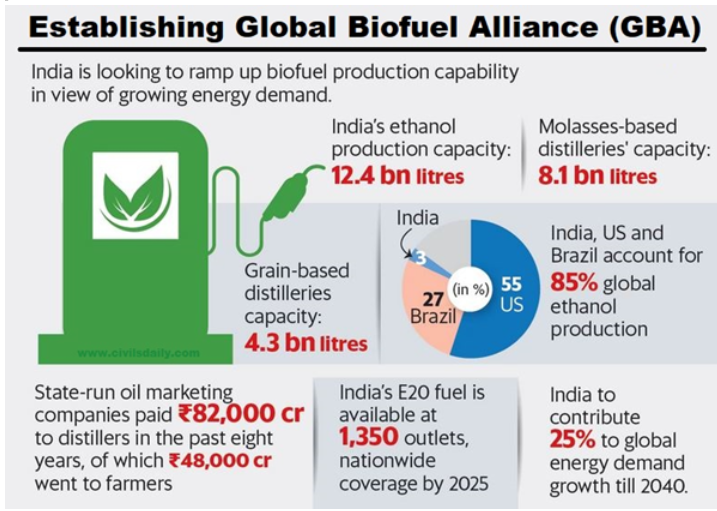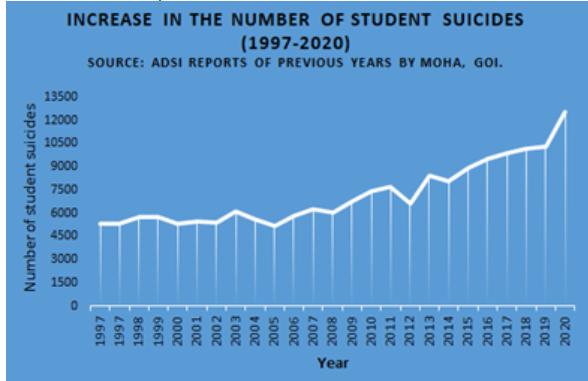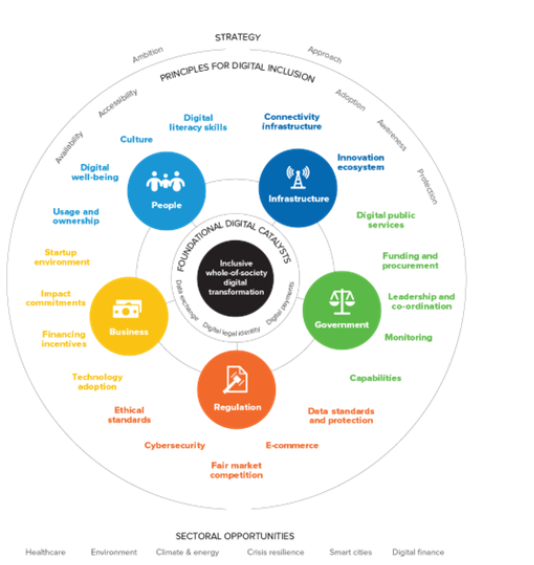Thursday, 28th September 2023
Climate Change and the Indian Dairy Sector
In News: India, the world’s largest milk producer for over half a century, is struggling with runaway milk prices. Despite producing a quarter of global milk production, milk prices are at an all-time high. Average retail price of milk has increased by 18 % in the past two years.
Causes of Inflation in prices of milk:
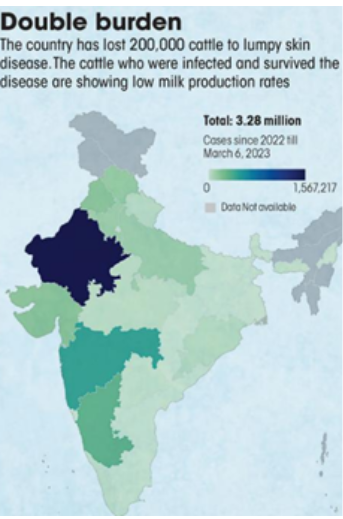
- Infectious lumpy skin disease: The viral pox disease LSD is novel to the country and has infected 3.2 million cattle and buffaloes across the country in the past year and killed over 0.2 million animals.
- Milk production of the surviving animals has dropped by 20 to 50%,
- Rebound in consumer demand: During COVID the demand and production of milk took hit. However post COVID increased demand for milk and milk products were witnessed, leading to increase in price.
- Missing 17 million Cattles: According to an estimates the country has likely missed 16.84 million artificial inseminations and have led to stagnation in the number of high-yield dairy cattle and buffaloes between 2020 and 2022.
- This led to double burden of milk loss and incurring additional maintenance cost till the animal enters the next oestrus cycle.
- Fodder Inflation: Farmers faced an acute shortage of dry fodder (wheat straw, along with other items) in 2022, and have been facing a steady fodder inflation since then. The shortage was fuelled by fall in wheat stocks due to an unusually hot March 2022.
What is Artificial Insemination?
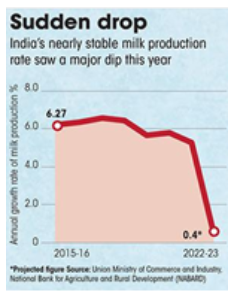
- In artificial insemination technology, semen is collected from a bull with proven superior genetic merits and is stored at ultra-low temperatures (known as cryopreservation) at the country’s more than 99,000 artificial insemination centres.
- It is then introduced to the reproductive tract of the female cattle at a time when it is ready for conception (also known as oestrus period that coincides once in 21 days).
- The Union government implements the Nationwide Artificial Insemination Programme (NAIP), as part of the Rashtriya Gokul Mission scheme for genetic upgradation of all breeds of bovines and enhances their milk productivity using advanced technologies.
Factors affecting the Indian Dairy Sector:
- Climate Impact:
- Milk Productivity: Increasing temperatures could decrease milk production and reproductive success in cattle. Increasing temperatures could reduce milk production in India’s arid and semi-arid regions by 25% by the end of 2085.
- Increased sensitivity to heat stress: Lactating dairy cows have an increased sensitivity to heat stress. Furthermore, higher yielding cows are more challenged by heat stress than lower yielding animals.
- Reproductive success: Heat stress also decreases reproductive success. Elevated temperatures affect the cow’s ability to display natural mating behaviour, as it reduces both the duration and intensity of oestrus expression.
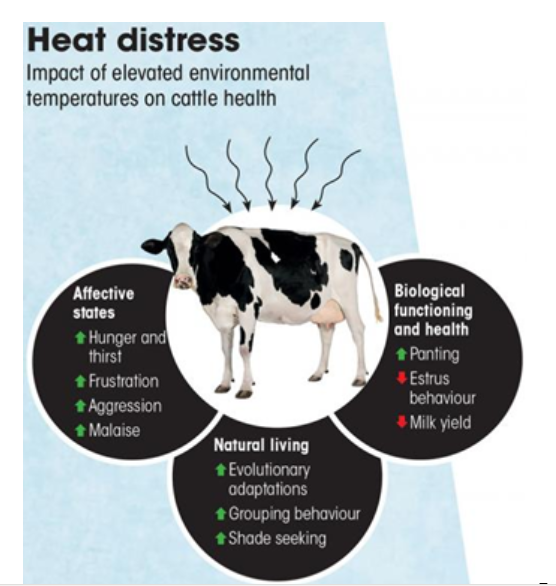
- Exodus of Dairy Farmers: Dairy farmers find the sector is no longer lucrative and that they are incurring huge losses. This is leading to an exodus of farmers from the dairy sector.
- Government Policies:
- Sex-sorted semen production: The policy aims to produce semen of only female calves up to “90% accuracy”. This has been done to enhance milk production and limit stray cattle population. However this policy overlooks the utility of male cattle and could eliminate them slowly.
- Anti-Slaughter rules: There is also the issue of the utility of female animals after they become unproductive, because it has become difficult to sell cows due to the anti-slaughter rules across many States.
India’s GDP measurement and its limitations
In News: Recently, a number of experts have drawn attention to a disparity in India's GDP numbers that masks underlying problems including growing inequality.
Gross Domestic Product (GDP):
- GDP is the gross valuation of all the goods and services generated within a country's borders for a specific period, generally one financial year.
- The GDP of a nation may be utilized to measure its growth and economic advancement.
- India’s GDP is calculated by the Central Statistics Office (CSO), which is part of the Ministry of Statistics and Program Implementation (MoSPI).
Types of GDP:
- Real GDP:
- Real GDP is an economic metric that is used to describe the economic output of a country within a specific year. It reflects the value of all goods and services produced while factoring inflation into its calculation. At present, the base year for calculating India's Real GDP is 2011-12.
- Nominal GDP:
- Nominal gross domestic product (GDP) is GDP given in current prices, without adjustment for inflation.
- Nominal GDP is seen by the government as a more realistic indication of economic growth.
Calculation of GDP:
- Expenditure Method:
- This method considers the total expenditure on goods and services made by every individual inside a single economy.
- GDP = Consumption Expenditure (C) + Investment Expenditure (I) + Government Spending (G) + Net Export (Nx)
- Income Method:
- This method takes account of the gross revenue generated inside a nation's borders by different production factors, such as labor and capital.
- GDP calculated based on this approach is known as GDI or Gross Domestic Income.
- GDP = Wage + Rent + Interest + Profit
- Output Method:
- This approach is used to determine the market value of all the services and products produced within a country.
- This method aids in removing any discrepancy in GDP measurement brought on by fluctuations in pricing levels.
Limitations Of GDP:
- GDP excludes non-market activities including domestic, volunteer, and other participations that have a beneficial effect on productivity. Additionally, goods produced for personal use are not included.
- GDP does not reflect the unequal distribution of income as seen in the case of India.
- The Standard of Living cannot be estimated by GDP, India has a high GDP but the living standards is relatively low in India.
- The Environmental Impact of growth and social well-being are not explained by GDP.
Concerns with the current calculation of GDP:
- The country’s GDP is presently computed with the base year of 2011-12 which is now more than 10 years old. Under normal circumstances, the base should have been revised after five years in 2016-17, with the readiness for another revision for 2021-22.
- GDP estimates based on an outdated base would not adequately capture new activities being undertaken in the economy like large investments in infrastructure, large inflow of foreign investment, value addition due to diversification, adoption of efficient technologies, and increased capacity.
- The Ministry of Statistics and Programme Implementation (MoSPI) has not come out with the results of various surveys like the consumer expenditure survey and the annual survey on unincorporated enterprises which are crucial for the base revision exercise.
- There is a need for the introduction of Supply Use Tables (SUTs) which are critical for the validation of national accounts statistics. This would also take care of confusion faced by some of the followers of national account statistics in understanding the “discrepancies” brought out in the estimates as a balancing term on the expenditure side of GDP.
Way Forward:
- MoSPI should initiate the process by constituting an advisory committee on National Accounts Statistics with professional experts from academia, industry and civil society and also set up working groups for the revision of the base year.
- A decision on the new base year should be taken at the highest level after due consideration of data availability and an assessment of whether the year has been normal or not.
- Steps should also be taken to change the base for all relevant price and production indices.
https://indianexpress.com/article/opinion/columns/gdp-better-way-capture-growth-picture-8952711/
World Coffee Conference - Edukemy Current Affairs
Why in News: Recently, the International Coffee Organisation (ICO) hosted the 5th World Coffee Conference (WCC) in Bengaluru.
Key highlights of the 5th World Coffee Conference (WCC):
- The ICO focused on highlighting the economic importance of coffee.
- It is being held for the first time in an Asian coffee-producing country.
- "Regenerative agriculture," a comprehensive agricultural method was one of the main themes covered during the conference.
- Regenerative Agriculture:
- It is a comprehensive agricultural strategy that emphasizes reducing soil disturbance, diversifying crops, utilizing cover crops, and including livestock in order to improve soil health, biodiversity, and sustainability.
- By adhering to concepts like conservation tillage, crop variety, soil cover with cover crops, and livestock integration, it seeks to increase resources rather than depleting them.
Conditions required for Coffee Plantation:
- Climate: Hot and Humid; Dry weather is necessary at the time of ripening of the berries.
- Rainfall: High (150 – 250 cm)
- Ideal Soil Conditions: Well-drained loamy soils, Presence of humus and minerals (iron, calcium), Fertile volcanic red earth, and Deep sandy loam soils.
Coffee Production:
- In India:
- Karnataka (Highest) > Kerala > Tamil Nadu > Andhra Pradesh.
- Karnataka accounts for approximately 70% of India's total coffee production.
- Global Production:
- Brazil is the largest producer.
- India’s position is 6th (65 – 70% of India’s coffee is exported).
Coffee Varieties in India:
- Arabica: Grown at higher altitudes and it has Higher market value due to its aroma.
- Robusta: Known for its strength and used in various blends.
International Coffee Organization (ICO):
- ICO was established in 1963, under the United Nations and is headquartered at London.
- It serves as the only intergovernmental organization for coffee.
- It administers the International Coffee Agreement (ICA), an important instrument for development cooperation.
- Aim to strengthen the coffee sector and promote sustainable growth for the Global Coffee Value Chain (G-CVC).
- It has 43 exporting members (including India) and 6 importing members.
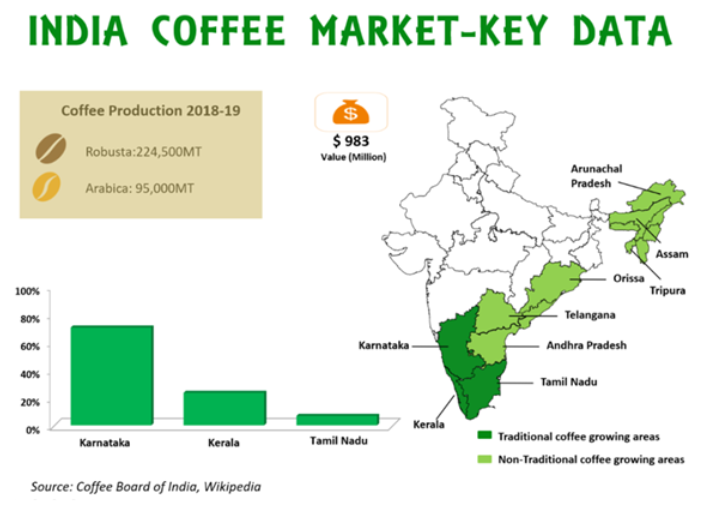
Gita Mittal Committee - Edukemy Current Affairs
In News: Recently, The Supreme Court of India has informed petitioners involved in the Manipur ethnic violence case that it cannot oversee the administration of the state and encouraged petitioners to place their trust in the Justice Gita Mittal Committee to address the issues raised in the case.
About:
- The Justice Mittal Committee was constituted by the Supreme Court to intervene and monitor relief and rehabilitation, restoration of homesteads, religious places of worship, etc, in Manipur.
- The committee will look into the issues include:
- The distribution of Aadhaar cards and disability certificates to the displaced people of the State,
- distribution of compensation to the families of the dead,
- reconstruction of religious buildings and homes damaged during the violence,
- handling of bodies, and
- the functioning of courts in the state.
SC judgments regarding Manipur violence:
- The State shall appoint a nodal officer in Delhi to guide people who had fled Manipur during the violence by helping them file complaints and petitions with the appropriate authorities in the State.
- The video-conferencing facilities shall be installed in district courts of Manipur within a week, and violation of it may bring the case of “contempt of court” against the State.
Unified Registration Portal for GOBARdhan
In News: Recently, The Department of Drinking Water and Sanitation (DDWS), Ministry of Jal Shakti has introduced a Unified Registration Portal for GOBARdhan to streamline the registration of Compressed Bio-Gas (CBG) and biogas plants nationwide.
About:
- Galvanizing Organic Bio-Agro Resources Dhan (GOBARdhan) is an umbrella initiative of the Government of India.
- It aims to transform organic waste, including cattle dung, agricultural residues, and biomass, into valuable resources like biogas, CBG, and organic manure.
- The Department of Drinking Water and Sanitation, Ministry of Jal Shakti is the coordinating department for GOBARdhan.
- This initiative supports high-value Biogas/CBG production and promotes the use of bio-slurry to improve soil health, carbon content, and water retention.
Unified Registration Portal for GOBARdhan:
- Anyone who operates or intends to set up a biogas/ CBG/ Bio CNG plant in India can obtain a registration number by registering in this unified registration portal.
- The registration number is required to avail benefits/ support from other Ministries/ Departments.
More information about the news:
- Department of Drinking Water and Sanitation (Nodal Department for GOBARdhan) announced that over 1163 biogas plants and 426 CBG plants have successfully registered on the portal to date.
- These registered CBG/Biogas plants are eligible for assistance under the Market Development Assistance (MDA) scheme of the Department of Fertilizers, Ministry of Chemicals & Fertilizers.

Foreign Contribution Regulations Act
In News: Recently, Ministry of Home Affairs (MHA) has amended the rules related to the filing of annual returns by Non-Government Organizations (NGOs) registered under the Foreign Contribution Regulation Act (FCRA).
About:
- These changes involve the requirement for NGOs to provide details about both movable and immovable assets created using foreign funds.
- Significance: The amendment aims to enhance transparency and accountability in the utilization of foreign contributions received by NGOs.
Foreign Contribution Regulations Act (FCRA)
- FCRA was enacted during the Emergency in 1976 amid apprehensions that foreign powers were interfering in India’s affairs by pumping money into the country through independent organisations.
- The law sought to regulate foreign donations to individuals and associations so that they functioned in a manner consistent with the values of a sovereign democratic republic.
- Criteria:
- The FCRA requires every person or NGO seeking to receive foreign donations to be:
- registered under the Act
- to open a bank account for the receipt of foreign funds in the State Bank of India, Delhi
- to utilize those funds only for the purpose for which they have been received and as stipulated in the Act.
- FCRA registrations are granted to individuals or associations that have definite cultural, economic, educational, religious, and social programs.
- The FCRA requires every person or NGO seeking to receive foreign donations to be:
Indian Standards on Biofuel to Aid GBA’s Clean Energy Goals
In News: The Bureau of Indian Standards (BIS), the National Standards Body of India commits to complement the green initiatives of the country through the development of relevant standards.
About
- The Bureau of Indian Standards (BIS) has developed nine Indian standards on biofuels, including specifications for anhydrous ethanol, biodiesel, biogas, biodiesel-diesel fuel blends, hydrous ethanol, E85 fuel, E20 fuel, aviation turbine fuel containing synthesized hydrocarbons, and ethanol as a fuel for spark-ignition engine-powered vehicles.
- BIS is working on a standard for paraffinic (green) diesel derived from 2G feedstock.
Kole wetlands - Edukemy Current Affairs
In News: Kole wetlands of Kerala face the threat of alien plants
About
- The Kole wetlands in Kerala, a Ramsar site of international importance celebrated for its rich biodiversity, are confronting a fresh menace in the form of an invasive alien plant species known as ‘Cabomba furcuta’, commonly referred to as Pink Bloom.
- This species, originally hailing from Central and South America, was initially introduced to Kerala as an aquarium plant but has now emerged as a serious threat to the Kole fields, exacerbating existing challenges posed by invasive species like water hyacinth and Salvinia molesta.
- Despite its visually striking pink flowers, ‘Cabomba furcuta’ presents a substantial risk to the region's biodiversity and agricultural productivity.
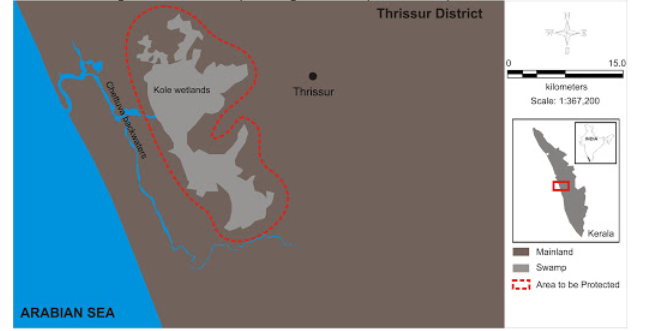
Creative industries can boost economies
Exam View: Creative industry in India; Boosting economies: India and the UK.
Context: Arts and culture exchanges between India and the UK contribute to economic growth and foster understanding between cultures.
Decoding the editorial: Creative industry in India
- Prime Minister (PM) in his opening address to the G20 Culture Ministers’ summit in Varanasi spoke of the value artists and craft workers contribute to the economic success of creative industries.
- The G20 Leaders Declaration emphasizes how culture is a key driver of the SDGs.
- The Nataraja, a statue of Hindu lord Shiva as the cosmic dancer, installed next to 'Bharat Mandapam', the main venue of the G20 Summit, is pictured in Delhi.
 Boosting economies: India and the UK
Boosting economies: India and the UK
- Cultural exchange: Arts and culture make tangible the “living bridge” between these countries.
- India’s Symphony Orchestra is touring concert halls across the UK later this year.
- The renowned Aditi Mangaldas dance company is premiering its new dance show at Sadler’s Wells Theatre in London in October.
- Aakash Odedra from Leicester, UK will be performing in Delhi as part of a new series of events led by the Kiran Nadar Museum of Art.
- The recent partnerships with the UK’s science museum group and the National Council for Science Museums for an exhibition on vaccines and their evolution.
- It shows how the mutual exchange of skills, talent, and creativity can enrich lives in India and the UK.
- It is a first-of-its-kind creative fellowship for skills exchange to develop young art talent in Scotland and India between Edinburgh Printmakers and Flow India, the Natural History Museum, and the Bihar Museum.
- The “Econario” sculpture graces the G20 Together We Art exhibition.
- Economic benefits: The contribution of the individual artists and those who support them to the economy should not be underestimated.
- In the pre-Covid period, India’s creative industries contributed 2.5% to India’s Gross Domestic Product (GDP) and the UK’s creative industries contributed 6% to the UK’s GDP.
- The UK's creative industries have grown 1.5 times faster than other industry sectors in the past decade.
- In Bengaluru and Hyderabad, the growth in tech, arts, gaming, and Artificial Intelligence coupled with India’s rapid digital transformation over the last five years has led start-ups to scale up.
- This is echoed in the UK government’s vision for creative industries which aims to add one million jobs in MSMEs and creative start-ups by 2030, an increase of 43%.
- Collaborations:
- The UK can learn from the sustainable practices of the Indian arts sector and from the cultural practices in Indian cities.
- The India-UK collaboration in the creative sectors has great potential to inform cultural policy development for the future.
- The British Council is enabling enduring connections between both countries catalyzing this exchange.
- The UK minister of arts and heritage, had met cultural policymakers, artists, and arts sector leaders in Delhi before heading to the G20 Culture Ministers meeting in Varanasi in August.
The creative economy is set to get a huge boost with the culture ministry’s G20 vision for One Family working together to deepen opportunities for all through the cultural industries and the UK’s longstanding commitment to India.
Source: https://www.hindustantimes.com/opinion/creative-industries-can-boost-economies-101695402454143.html
Share the article
Edukemy’s Current Affairs Quiz is published with multiple choice questions for UPSC exams
MCQ
Get Latest Updates on Offers, Event dates, and free Mentorship sessions.

Get in touch with our Expert Academic Counsellors 👋
FAQs
UPSC Daily Current Affairs focuses on learning current events on a daily basis. An aspirant needs to study regular and updated information about current events, news, and relevant topics that are important for UPSC aspirants. It covers national and international affairs, government policies, socio-economic issues, science and technology advancements, and more.
UPSC Daily Current Affairs provides aspirants with a concise and comprehensive overview of the latest happenings and developments across various fields. It helps aspirants stay updated with current affairs and provides them with valuable insights and analysis, which are essential for answering questions in the UPSC examinations. It enhances their knowledge, analytical skills, and ability to connect current affairs with the UPSC syllabus.
UPSC Daily Current Affairs covers a wide range of topics, including politics, economics, science and technology, environment, social issues, governance, international relations, and more. It offers news summaries, in-depth analyses, editorials, opinion pieces, and relevant study materials. It also provides practice questions and quizzes to help aspirants test their understanding of current affairs.
Edukemy's UPSC Daily Current Affairs can be accessed through:
- UPSC Daily Current Affairs can be accessed through Current Affairs tab at the top of the Main Page of Edukemy.
- Edukemy Mobile app: The Daily Current Affairs can also be access through Edukemy Mobile App.
- Social media: Follow Edukemy’s official social media accounts or pages that provide UPSC Daily Current Affairs updates, including Facebook, Twitter, or Telegram channels.

